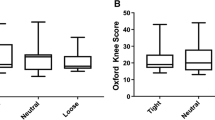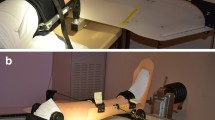Abstract
Background
Clinical observation of increased laxity has been noted in native Canadians. Comparative studies support the possible relationship between joint hypermobility and the development of osteoarthritis or other joint ailments. If joint laxity predisposes to osteoarthritis, there may be far-reaching consequences to the general Native population.
Methods
A cohort of 52 Native Canadians (NC) and 52 non-Native Canadians (NNC) were evaluated for knee laxity. All patients had no prior history of knee injury or complaints of symptoms related to knee pathology at the time of the examination. Bilateral knee examination was performed. Objective laxity was measured using the KT-1000 tensiometer. Subjective findings were also recorded.
Results
Comparison for instability between the groups (NC and NNC) revealed that the NC group had significantly greater laxity on both right and left sides for all knee ligament grading (p≤0.0001). The values for displacement during KT-1000 measurements were significantly greater in the NC group for all forces (p≤0.0001). Presence of all the following were also significantly greater in the NC group: pivot shift (p≤0.001); medial and lateral collateral ligament opening (p≤0.001); posterior cruciate drawer test (p≤0.001).
Interpretation
This prospective matched cohort reveals that there is a significant joint hypermobility in this Native Canadian population.
Résmé
Contexte
La laxité ligamentaire est une condition prévalente chez les autochtones canadiens. L’hypermobilité articulaire est impliquée dans le développement de pathologies articulaires telles que l’arthrose selon certaines études cliniques. Cette population présente donc un risque plus élevé de pathologies articulaires si cette hyperlaxité est confirmée.
Méthode
Une cohorte de 52 Canadiens autochtones (CA) et une autre de 52 Canadiens non-autochtones (CNA) ont été évaluées pour la laxité ligamentaire aux genoux. Aucun patient n’avait d’antécédents de trauma aux genoux, ni de plaintes liées à une pathologie du genou au moment de l’évaluation. Nous avons procédé à un examen clinique bilatéral du genou. Nous avons mesuré la laxité ligamentaire de façon objective avec le tensiomètre KT-1000, puis effectué une évaluation subjective.
Résultats
La comparaison clinique a démontré une instabilité ligamentaire statistiquement plus significative pour tous les ligaments des genoux droit et gauche chez les Canadiens autochtones (CA) (p≤0,0001). Les résultats de déplacement avec le KT-1000 ont aussi été significativement plus élevés chez les CA pour toutes les forces testées (p≤0,0001). Les tests cliniques de stabilité ligamentaire du genou suivants ont aussi été plus fréquents chez les CA: le pivot-glissement (p≤0,001), le bâillement du ligament collatéral interne et externe (p≤0,001) et le tiroir postérieur (p≤0,001).
Interprétation
Cette étude prospective de cohorte démontre une laxité ligamentaire importante du genou chez cette population de Canadiens autochtones.
Similar content being viewed by others
References
Arroyo I, Brewer E, Giannini E. Arthritis/arthralgia and hypermobility of the joints in schoolchildren. J Rheumatol 1988;15(6):978–80.
Beighton P, Solomon L, Soskolne C. Articular mobility in an African population. Ann Rheum Dis 1973;32(5):413–18.
Bird H, Tribe C, Bacon P. Joint hypermobility leading to osteoarthrosis and chondrocalcinosis. Ann Rheum Dis 1978;37(3):203–11.
Brage M, Draganich L, Pottenger L, Curran J. Knee laxity in symptomatic osteoarthritis. Clin Orthop 1994;304:184–89.
Dolan A, Hart D, Doyle D, Grahame R, Spector T. The relationship of joint hypermobility, bone mineral density, and osteoarthritis in the general population: The Chingford study. J Rheumatol 2003;30(4):799–803.
Hudson N, Fitzcharles M, Cohen M, Starr M, Esdaile J. The association of soft-tissue rheumatism and hypermobility. Br J Rheumatol 1998;37:382–86.
Jonsson H, Valtysdottir S, Kjartansson O, Brekkan A. Hypermobility associated with osteoarthritis of the thumb base: A clinical and radiological subset of hand osteoarthritis. Ann Rheum Dis 1996;55(8):540–43.
Sharma L, Hayes K, Felson D, Buchanan T, Kirwan-Mellis G, Lou C, et al. Does laxity alter the relationship between strength and physical function in knee osteoarthritis? Arthritis Rheum 1999;42(1):25–32.
Sharma L, Lou C, Felson D, Dunlop D, Kirwan-Mellis G, Hayes K, et al. Laxity in healthy and osteoarthritic knees. Arthritis Rheum 1999;42(5):861–70.
van der Giessen L, Liekens D, Rutgers K, Hartman A, Mulder P, Oranje A. Validation of Beighton score and prevalence of connective tissue signs in 773 Dutch children. J Rheumatol 2001;28(12):2726–30.
Wada M, Imura S, Baba H, Shimada S. Knee laxity in patients with osteoarthritis and rheumatoid arthritis. Br J Rheumatol 1996;35(6):560–63.
Walker J. Generalized joint laxity in Igloolik Eskimos and in Island Lake Amerindians. Hum Biol 1975;47(2):263–75.
MacMillan H, MacMillan A, Offord D, Dingle J. Aboriginal health. CMAJ 1996;155(11):1569–78.
Haworth J, Dilling L, Seargeant L. Increased prevalence of hereditary metabolic diseases among native Indians in Manitoba and northwestern Ontario. CMAJ 1991;145(2):123–29.
Jessee E, Owen DJ, Sagar K. The benign hypermobile joint syndrome. Arthritis Rheum 1980;23(9):1053–56.
Highgenboten C, Jackson A, Jansson K, Meske N. KT-1000 arthrometer: Conscious and unconscious test results using 15, 20, and 30 pounds of force. Am J Sports Med 1992;20(4):450–54.
Brosky JJ, Nitz A, Malone T, Caborn D, Rayens M. Intrarater reliability of selected clinical outcome measures following anterior cruciate ligament reconstruction. J Orthop Sports Phys Ther 1999;29(1):39–48.
Malanga G, Andrus S, Nadler S, McLean J. Physical examination of the knee: A review of the original test description and scientific validity of common orthopedic tests. Arch Phys Med Rehabil 2003;84(4):592–603.
Kim S, Kim H. Reliability of the anterior drawer test, the pivot shift test, and the Lachman test. Clin Orthop 1995;317:237–42.
Cooperman J, Riddle D, Rothstein J. Reliability and validity of judgments of the integrity of the anterior cruciate ligament of the knee using the Lachman’s test. Phys Ther 1990;70(4):225–33.
Author information
Authors and Affiliations
Additional information
Study conducted at the Division of Orthopedic Surgery McGill University Health Center No financial support was received by the authors in connection with this study.
Rights and permissions
About this article
Cite this article
Steinitz, D.K., Harvey, E.J., Berry, G.K. et al. Knee Joint Laxity in a Native Canadian Indian Population. Can J Public Health 96, 226–229 (2005). https://doi.org/10.1007/BF03403696
Received:
Revised:
Accepted:
Published:
Issue Date:
DOI: https://doi.org/10.1007/BF03403696




